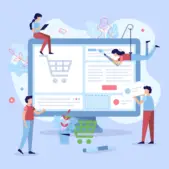Even UX is subject to the primary tenet of evolution—survival of the fittest. After years of experimentation in web design, industry standards and best practices have been firmly established and accepted by a majority of developers and designers. Even mobile, which is a relatively new interface by comparison, leaned on a set of OS-reinforced design element standards and has had the time needed for specialists to define what makes for a satisfying user experience.
Just as we’ve started to become comfortable with task of designing a gratifying website or mobile application, a number of new technologies are emerging that, as yet, do not have a set of defined guidelines for best meeting user expectations. To make matters more challenging, many of these technologies move beyond the two-dimensional confines of a screen which users have become accustomed.
Virtual and augmented reality are two such technologies. It will be difficult to anticipate user expectations using traditional design practices when designing VR or AR applications because the interface is entirely new. Without putting this technology into the hands of users, designers and developers may not know there is an issue until the product has been launched.
Chatbots, too, continue to increase in popularity thanks to the growth of messaging services like Slack, which is starting to seem ubiquitous in the tech industry now, and Microsoft’s new competitor in that space called Teams. But developers cannot possibly account for every possible interaction that users may have with these bots, so it becomes increasingly important to conduct testing.
User testing will be even more critical for virtual assistants like Amazon’s Echo and Google Home. The makers of virtual assistants have made it easy to support third party skills. This, however, puts the onus onto designers to build applications that will work intuitively despite the fact that users don’t physically interact with the products in any way.
There is a stark difference between user experience across web or mobile compared to these emerging technologies. Even the most poorly designed website will have been built with a shared set of standards and common experiences in mind. Imagine, for example, the very first website your 13 year-old nephew puts together for a class project. Sure, it might have poor navigation and consist of loosely organized text but I doubt any of us would hold that against him. Now imagine you’re tasked with locating a particular piece of information. Although you may be frustrated by the time you do, and may even have pulled some of your hair out along the way, it is likely that with a little trial and error you’d eventually find what you’re looking for. This can be attributed largely to the common set of design principles (with which you are both accustomed to seeing as end users yourselves) likely used to create it.
But now consider an app for the Echo (a “skill,” as Amazon calls them), they likely did not have the knowledge or precedent to prepare for the infinite number of ways you may try to inquire about something. This applies even to simple requests like what types of restaurants are nearby or what movies you might be interested in. If you were to ask about theaters “downtown”, for instance, the Echo may not understand what you mean. Nuanced references to people, places, and things that we’re all too familiar in everyday conversations become tricky when designing them into digital experiences. For example, the last thing you want when you gather your little ones around the couch at home and say, “Show me a kids movie” is for 2008’s horror film “The Children” to start playing! UX Designers must not only anticipate the numerous ways users might interact with the experience, they also need to take into account the interpretation and action side of what users expect as a response, or result.
Compounding and convoluting these challenges even further is the introduction of the Internet of Things (“IoT”), which may cast a shadow over all the aforementioned technologies. IoT, which itself is continually evolving at an astounding rate, can interact with data, services, and other devices in ways that are unfamiliar to a majority of web users. Often, these devices have no visual interface at all and rely only on a set of buttons and indicator lights for users to figure things out.
It is surely only a matter of time before industry standards are applied to these emerging technologies, just as we have seen with web and mobile design. At this juncture, however, designers have few standards or experiences to draw upon guiding their decision-making. Thus, it is imperative to conduct user testing to inform every decision being made. Failure to do so may result in stalled product launches and unnecessary expenditures.
If your organization is preparing to launch a new product, be sure to make it a priority to speak with our user experience testing specialists.


